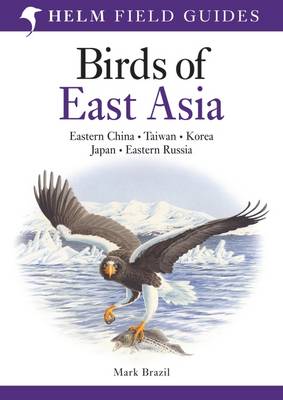Helm Field Guides
3 total works
This is the first single volume guide ever devoted to the eastern Asian avifauna. The eastern Asian region, centering especially on the major islands off the continental coast (including Japan and Taiwan) and the immediately adjacent areas of the Asian continent from Kamchatka in the north and including the Korean Peninsula are an important centre of endemism. Birds endemic to this region include representatives of many of the major families, from the world's largest eagle - Steller's Sea Eagle - to the tiny Taiwan Firecrest. The east Asian continental coast and the offshore islands also form one of the world's major international bird migration routes, especially for waterfowl, shorebirds and raptors, while the east Asian continental mainland itself is home to a wide range of species little known to western ornithologists such as Scaly-sided Merganser, Oriental Stork and Mugimaki Flycatcher. The guide features the most up-to-date text available, which, in conjunction with extensive colour plates throughout, facilitates the field identification of all of the species known from the region.
Colour distribution maps enhance the text by providing a visual analysis of the summer, winter and migratory ranges of all species.
Colour distribution maps enhance the text by providing a visual analysis of the summer, winter and migratory ranges of all species.
Japan, with its great range of climatic zones and habitats and consequently its exciting mix of species, is a fascinating country in which to birdwatch. The Japanese archipelago is on the migration route of many species breeding in Siberia and wintering in mainland southeast Asia, in Indonesia and even Australasia. It is the wintering grounnd for many northern birds, for thousands of cranes, hundreds of thousands of waterfowl, thrushes and buntings and the breeding ground for a wide variety of species of more southerly origin. The long isolation of the archipelago has been conducive to the evolution of numerous distinct sub-species and also a number of endemic species. The range is extraordinary from the northern pink-cheeked and grey-breasted bullfinch, to the southern local race of the Narcissus flycatcher in the Nansei Shoot; even some of the endemic species have distinct populations. Over the last two decades there has been a marked increase in the number of Japanese birdwatchers, as leisure pursuits have become fashionable and as the Japanese have become increasingly affluent. The science of ornithology has expanded too during the same period, resulting in a major advance in the study of Japanese birds. This book brings together information on the avifauna of Japan. It is not designed as a field guide but as a comprehensive overview of the status, range, habits of Japanese birds.


